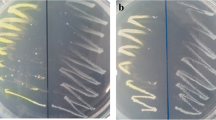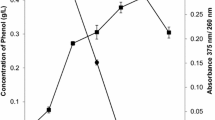Abstract
This study intends to purify and characterize catechol 1,2-dioxygenase (C1,2O) of phenol-degrading Acinetobacter sp. Y64 and of E. coli transformant. Acinetobacter sp. Y64 was capable of degrading 1000 mg/L of phenol within 14 ± 2 h at 30 °C, 160 rpm and pH of 7. One C1,2O of 36 kDa was purified using ammonium sulphate precipitation and Hitrap QFF column chromatograph with 49 % recovery and a 10.6-fold increase in purity. Purified Y64 C1,2O had temperature and pH optimum at 37 °C and pH 7.7 respectively with the Michaelis constant of 17.53 µM and the maximal velocity of 1.95 U/mg, respectively. The presence of Fe3+ or Fe2+ enhanced the activity of Y64 C1,2O while other compounds such as Ca2+, and EDTA had an inhibitory effect. 80 % of C1,2O activity remained using 4-nitrocatechol as substrate while 2 % remained using 3-methylcatechol compared with that using catechol. Y64 catA gene encoding C1,2O was amplified using PCR cloned into pET22b vector and expressed in Escherichia coli BL21 DE3 (pLysS) after transformation. Purified and cloned Y64 C1,2O show no significant differences in the biochemical properties. The phylogenetic tree based on the protein sequences indicates that these C1,2Os possess a common ancestry.









Similar content being viewed by others
Abbreviations
- BH:
-
Bushnell Haas
- bp:
-
Basepair
- C1,2O:
-
Catechol 1,2-dioxygenase
- C2,3O:
-
Catechol 2,3 dioxygenase
- IPTG:
-
Isopropyl β-d-1-thiogalactopyranoside
- K m :
-
Michaelis constant
- PCR:
-
Polymerase chain reaction
- QFF:
-
Q Sepharose® Fast Flow
- SDS-PAGE:
-
Sodium dodecyl sulfate-polyacrylamide gel electrophoresis
- V max :
-
The maximum rate of reaction
References
Nadaf NH, Ghosh JS (2011) Purification and characterization of catechol 1,2 dioxygenase from Rhodococcus sp. NCIM 2891. Res J Environ Earth Sci 3(5):608–613
Yan J, Wen J, Jia X, Caiyin Q, Hu Z (2007) Mutation of Candida tropicalis by irradiation with a He–Ne laser to increase its ability to degrade phenol. Appl Environ Microbiol 73(1):226–231
Curran KA, Leavitt JM, Karim AS, Alper HS (2013) Metabolic engineering of muconic acid production in Saccharomyces cerevisiae. Metab Eng 15:55–66
Niu W, Draths KM, Frost JW (2002) Benzene-free synthesis of adipic acid. Biotechnol Prog 18:201–211
Kaneko A, Ishii Y, Kirimura K (2011) High-yield production of cis, cis-muconic acid from catechol in aqueous solution by biocatalyst. Chem Lett 40:381–383
Polen T, Spelberg M, Bott M (2013) Toward biotechnological production of adipic acid and precursors from biorenewables. J Biotechnol 167:75–84
Lin J, Sharma V, Milase R, Mbhense N (2015) Simultaneous enhancement of phenolic compound degradations by Acinetobacter strain V2 via a step-wise continuous acclimation process. J Basic Microbiol. doi:10.1002/jobm.201500263.7
Pessione E, Giuffrida MG, Mazzoli R, Caposio P, Landolfo S, Conti A, Giunta C, Gribaudo G (2001) The catechol 1,2 dioxygenase system of Acinetobacter radioresistens: isoenzymes, inductors and gene localisation. Biological Chemistry 382(8):1253–1261
Yang L, Nguyen DM, Jia S, Reid JS, Yu LE (2013) Impacts of biomass burning smoke on the distributions and concentrations of C2–C5 dicarboxylic acids and dicarboxylates in a tropical urban environment. Atmos Environ 78:211–218
Pillar EA, Zhou R, Guzman MI (2015) Heterogeneous oxidation of catechol. J Phys Chem A 119:10349–10359
Desyaterik Y, Sun Y, Shen X, Lee T, Wang X, Wang T, Collett JL (2013) Speciation of “brown” carbon in cloud water impacted by agricultural biomass burning in eastern China. J Geophys Res-Atmos 118:7389–7399
Ali S, Fernandez-Lafuente R, Cowan DA (1998) Meta-pathway degradation of phenolics by thermophilic Bacilli. Enzyme Microb Technol 23:462–468
Nakajima H, Ishida T, Tanaka H, Horiike K (2002) Accurate measurement of near-micromolar oxygen concentrations in aqueous solutions based on enzymatic extradiol cleavage of 4-chlorocatechol: applications to improved low-oxygen experimental systems and quantitative assessment of back diffusion of oxygen from the atmosphere. J Biochem 131:523–531
Bushnell DL, Haas HF (1941) The utilization of certain hydrocarbons by microorganisms. Kans Agric Exp Stn 199:653–673
Klibanov AM, Alberti BN, Morris ED, Felsin LM (1980) Enzymatic removal of toxic phenols and anilines from wastewaters. J Appl Biochem 2:414–421
Briganti F, Pessione E, Giunta C, Scozzafava A (1997) Purification, biochemical properties and substrate specificity of a catechol 1,2-dioxygenase from a phenol degrading Acinetobacter radioresistens. FEBS Lett 416(1):61–64
Bradford M (1976) A rapid and sensitive method for the quantitation of microgram quantities of protein utilizing the principle of protein-dye binding. Anal Biochem 72:248–254
Laemmli UK (1970) Cleavage of structural protein during the assembly of the head of bacteriophage T4. Nature 227:680–685
Tsai S-C, Li Y-K (2007) Purification and characterization of a catechol 1,2-dioxygenase from a phenol degrading Candida albicans TL3. Arch Microbiol 187:199–206
Rozen S, Skaletsky H (2000) Primer3 on the WWW for general users and for biologist programmers. Methods Mol Biol 132:365–386
Vázquez-Laslop N, Lee H, Hu R, Neyfakh AA (2001) Molecular sieve mechanism of selective release of cytoplasmic proteins by osmotically shocked Escherichia coli. J Bacteriol 183(8):2399–2404
Guzik U, Hupert-Kocurek K, Sitnik M, Wojcieszyńska D (2013) High activity catechol 1,2-dioxygenase from Stenotrophomonas maltophilia strain KB2 as a useful tool in cis, cis-muconic acid production. Antonie Van Leeuwenhoek 103(6):1297–1307
Briganti F, Pessione E, Giunta C, Mazzoli R, Scozzafava A (2000) Purification and catalytic properties of two catechol 1,2-dioxygenase isozymes from benzoate-grown cells of Acinetobacter radioresistens. J Protein Chem 19(8):709–716
Caposio P, Pessione E, Giuffrida G, Conti A, Landolfo S, Giunta C, Gribaudo G (2002) Cloning and characterization of two catechol 1,2-dioxygenase genes from Acinetobacter radioresistens S13. Res Microbiol 153(2):69–74
Suzuki K, Ichimura A, Ogawa N, Hasebe A, Miyashita K (2002) Differential expression of two catechol 1,2-dioxygenases in Burkholderia sp. strain TH2. J Bacteriol 184(20):5714–5722
Miguez CB, Greer CW, Ingram JM (1993) Purification and properties of chlorocatechol 1,2-dioxygenase from Alcaligenes denitrifcans BRI 6011. Can J Microbiol 39:1–5
Patel RN, Hou CT, Felix A, Lillard MO (1976) Catechol 1,2-dioxygenase from Acinetobacter calcoaceticus: purification and properties. J Bacteriol 127:536–544
Strachan PD, Freer AA, Fewson CA (1998) Purification and characterization of catechol 1,2-dioxygenase from Rhodococcus rhodochrous NCIMB 13259 and cloning and sequencing of its catA gene. Biochem J 333(3):741–747
Saxena P, Thakur IS (2005) Purification and characterization of catechol 1,2-dioxygenase of Pseudomonas fluorescens for degradation of 4-chlorobenzoic acid. Indian J Biotechnol 4:134–138
Wang C, You S, Wang S (2006) Purification and characterization of a novel catechol 1,2-dioxygenase from Pseudomonas aeruginosa with benzoic acid as a carbon source. Process Biochem 41:1594–1601
Guzik U, Gren I, Hupert-Kocurek K, Wojcieszyńska D (2011) Catechol 1,2-dioxygenase from the new aromatic compounds—degrading Pseudomonas putida strain N6. Int Biodeterior Biodegrad 65:504–512
Aoki K, Konohana T, Shinke R, Nishira H (1984) Purification and characterization of catechol 1,2-dioxygenase from aniline-assimilating Rhodococcus erythropolis AN-13. Agric Biol Chem 48:2087–2095
Silva AS, Jacques RJS, Andreazza R, Bento LFW, Roesch FM, Camargo FAO (2013) Properties of catechol 1,2-dioxygenase in the cell free extract and immobilized extract of Mycobacterium fortuitum. Braz J Microbiol 44(1):291–297
Murakami S, Wang CL, Naito A, Shinke R, Aoki K (1998) Purification and characterization of four catechol 1,2-dioxygenase isozymes from the benzamide-assimilating bacterium Arthrobacter BA-5-17. Microbiol Res 153:163–171
An H-R, Park H-J, Kim E-S (2001) Cloning and expression of thermophilic catechol 1,2-dioxygenase gene (catA) from Streptomyces setonii. FEMS Microbiol Lett 195(1):17–22
Guo M, Qu YY, Zhou JT, Li A, Uddin MS (2009) Characterization of catechol 1,2 dioxygenase from cell extracts of Sphingomonas xenophaga QYY. Sci China Ser B Chem 52:615–620
Giedraityte G, Kalediene L (2009) Catechol 1,2-dioxygenase from a α-naphthol degrading thermophilic Geobacillus sp. strain: purification and properties. Cent Eur J Biol 4(1):68–73
Pakala SB, Gorla P, Pinjari AB, Krovidi RK, Baru R, Yanamandra M, Merrick M, Siddavattam D (2007) Biodegradation of methyl parathion and p-nitrophenol: evidence for the presence of a p-nitrophenol 2-hydroxylase in a Gram-negative Serratia sp. strain DS001. Appl Microbiol Biotechnol 73(6):1452–1462
Pandeeti EVP, Siddavattam D (2011) Purification and characterization of catechol 1,2-dioxygenase from Acinetobacter sp. DS002 and cloning, sequencing of partial catA gene. Indian J Microbiol 51(3):312–318
Varga JM, Neujahr Y (1970) Purification and properties of catechol 1,2-dioxygenase from Trichosporon cutaneum. Eur J Biochem 12:427–434
Houghton JE, Shanley MS (1994) Catabolic potential of Pseudomonads: a regulatory perspective. Dioscorides Press, Portland, pp 11–32
Sanakis Y, Mamma D, Christakopoulos P, Stamatis H (2003) Catechol 1,2-dioxygenase from Pseudomonas putida in organic media—an electron paramagnetic resonance study. Int J Biol Macromol 33(1–3):101–106
Miyazawa D, Mukerjee-Dhar G, Shimura M, Hatta T, Kimbara K (2004) Genes for Mn(II)-dependent NahC and Fe(II)-dependent NahH located in close proximity in the thermophilic naphthalene and PCB degrader, Bacillus sp. JF8: cloning and characterization. Microbiology 150(4):993–1004
Camargo FAO, Andreazza R, Baldoni DB, Bento FM (2012) Enzymatic activity of catechol 1,2-dioxygenase and catechol 2,3-dioxygenase produced by Gordonia polyisoprenivorans. Quim Nova 35(8):1587–1592
Vetting MW, Ohlendorf DH (2000) The 1.8 Å crystal structure of catechol 1,2 dioxygenase reveals a novel hydrophobic helical zipper as a subunit linker. Structure 8:429–440
Neidle EL, Hartnett C, Bonitz S, Ornston LN (1988) DNA sequence of the Acinetobacter calcoaceticus catechol 1,2 dioxygenase I structural gene cat A: evidence for evolutionary divergence of intradiol dioxigenases by acquisition of DNA sequence repetitions. J Bacteriol 170:4874–4880
Author information
Authors and Affiliations
Corresponding author
Rights and permissions
About this article
Cite this article
Lin, J., Milase, R.N. Purification and Characterization of Catechol 1,2-Dioxygenase from Acinetobacter sp. Y64 Strain and Escherichia coli Transformants. Protein J 34, 421–433 (2015). https://doi.org/10.1007/s10930-015-9637-7
Published:
Issue Date:
DOI: https://doi.org/10.1007/s10930-015-9637-7




